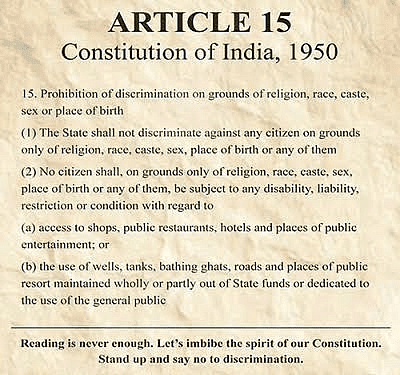MCQ (Solution) - Confronting Marginalisation | Social Studies (SST) Class 8 PDF Download
Q1: What is the primary focus of the chapter?
(a) Economic development of marginalized groups
(b) Historical analysis of marginalized communities
(c) How marginalized groups in India use their rights
(d) International perspectives on human rights
Correct Answer is Option (c)
The primarily focus of the chapter is how various groups in India, such as Adivasis, Dalits, Muslims, and women, utilise their rights as citizens to combat inequality and discrimination. Key points include:
- These groups assert their rights as citizens of a democratic nation.
- They rely on the Indian Constitution to address their grievances.
- Their struggles are shaped by their unique circumstances and histories.
- They employ various strategies, including protests and legal actions, to challenge unfair treatment.
Adivasi and Dalit
Q2: How do marginalized groups assert their Fundamental Rights according to the passage?
(a) By engaging in economic activities
(b) By forming political parties
(c) By demanding the enforcement of laws aligned with Fundamental Rights
(d) By boycotting public services
Correct Answer is Option (c)
Marginalized groups assert their Fundamental Rights through two main actions:
These efforts can lead to the creation of new laws that align with the spirit of the Fundamental Rights.
- They demand the government acknowledge the injustices they face.
- They insist on the enforcement of laws that protect these rights.
Q3: Which article of the Constitution bans untouchability, giving Dalits the right to go to school, visit temples, and use public places?
(a) Article 15
(b) Article 17
(c) Article 10
(d) Article 20
Correct Answer is Option (b)
Article 17 of the Constitution abolishes untouchability. This means:
Untouchability is now considered a crime, and the government is committed to enforcing this law. Other articles, like Article 15, further support equality by prohibiting discrimination based on religion, race, caste, sex, or place of birth.
- Dalits have the right to education.
- They can enter temples freely.
- They are allowed to use public facilities.
Q4: What does Article 15 of the Constitution prohibit?
(a) Discrimination based on religion, race, caste, sex, or place of birth
(b) Discrimination based on economic status
(c) Discrimination based on political affiliation
(d) Discrimination based on educational background
Correct Answer is Option (a)
Article 15 prohibits discrimination based on religion, race, caste, sex, or place of birth, empowering Dalits to seek equality where denied.
Q5: How do Dalits and other small groups use their basic rights when treated unfairly?
(a) By resorting to violence
(b) By organizing protests
(c) By using Fundamental Rights and asking the government to be fair
(d) By seeking international intervention
Correct Answer is Option (c)
Dalits and other small groups assert their basic rights when facing unfair treatment by:For example, Article 17 of the Constitution abolishes untouchability, ensuring that Dalits cannot be denied access to education, public facilities, or places of worship. This practice is now a punishable offence.
- Demanding that the Indian government uphold the Constitution.
- Insisting on their Fundamental Rights to highlight injustices.
- Pressuring the government to enforce existing laws.
- Influencing the creation of new laws that align with their rights.
Q6: What special plans do governments make in areas with many tribal or Dalit people to promote social justice?
(a) Economic development initiatives
(b) Infrastructure projects
(c) Reservation policies and free/cheaper hostels for education
(d) Cultural exchange programs
Correct Answer is Option (c)
Governments implement special plans to promote social justice for Dalit and Adivasi communities, including:
These measures aim to address historical inequities and provide opportunities for social and economic advancement.
- Reservation policies: These ensure a certain number of seats in education and government jobs for Dalits and Adivasis.
- Free or subsidised hostels: These accommodations help students access education facilities that may not be available locally.
- Special scholarships: Financial support is provided to help students from these communities pursue their studies.
Q7:What is the purpose of the Reservation Policy?
(a) To reserve jobs for the majority community
(b)To provide equal opportunities in schools and government jobs for marginalized groups
(c) To exclude certain communities from education and employment
(d) To favor economically privileged individuals
Correct Answer is Option (b)
The reservation policy aims to address historical unfairness by:
- Reserving places in schools and government jobs for marginalised groups.
- Providing opportunities for those who have been denied access to education and employment.
- Ensuring that disadvantaged communities, such as Dalits and Adivasis, receive support to improve their social and economic status.
Q8: How did Rathnam in Jakmalgur use the law to address unfair traditions at a festival?
(a) By organizing a protest
(b) By resorting to violence
(c) By seeking international assistance
(d) By using the Scheduled Castes and Scheduled Tribes (Prevention of Atrocities) Act, 1989
Correct Answer is Option (d)
Rathnam used the law to challenge unfair traditions at the festival by:
His actions aimed to confront the power dynamics in his village and promote equality.
- Refusing to perform a ritual that his family had been forced to do for generations.
- Arguing that the practice was unjust and rooted in discrimination against Dalits.
- Filing a case under the Scheduled Castes and Scheduled Tribes (Prevention of Atrocities) Act, 1989 to protect his rights.
- Bringing attention to his situation through local media, which highlighted the issue of caste-based oppression.
Q9: What is the primary purpose of the Scheduled Castes and Scheduled Tribes (Prevention of Atrocities) Act, 1989?
(a)To punish any criminal activities in society
(b) To protect the rights of Dalits and Adivasis against ongoing bad treatment
(c) To establish a new legal system
(d)To promote economic development in marginalized communities
Correct Answer is Option (b)
The Scheduled Castes and Scheduled Tribes (Prevention of Atrocities) Act, 1989 aims to protect vulnerable communities from discrimination and violence.
Its main objectives include:This Act was established in response to demands for serious action against the daily injustices faced by these groups.
- Addressing ongoing mistreatment of Dalits and Adivasis.
- Providing legal measures against acts of violence and humiliation.
- Ensuring punishment for those who exploit or harm these communities.
Q10: Why do Adivasi activists find the 1989 Act important?
(a) It promotes economic development in tribal lands
(b) It helps non-tribal people buy and sell tribal lands
(c) It protects the rights of Adivasis to reclaim their old lands
(d)It supports government projects in tribal lands
Correct Answer is Option (c)
Adivasi activists consider the 1989 Act crucial for several reasons:
Furthermore, the Act acknowledges the specific challenges faced by Adivasi women and seeks to penalise crimes against them.
- It protects their right to reclaim traditional lands.
- It prevents non-tribal individuals from buying or selling tribal lands.
- The Act confirms rights already promised in the Constitution.
- It allows for punishment of those who unlawfully occupy tribal land.
|
87 videos|558 docs|53 tests
|
FAQs on MCQ (Solution) - Confronting Marginalisation - Social Studies (SST) Class 8
| 1. What is marginalisation and how does it affect different communities? |  |
| 2. What are some common causes of marginalisation in society? |  |
| 3. How can individuals and communities confront marginalisation? |  |
| 4. What role does education play in addressing marginalisation? |  |
| 5. What are some successful examples of confronting marginalisation globally? |  |


















